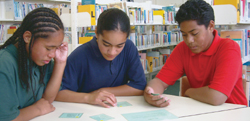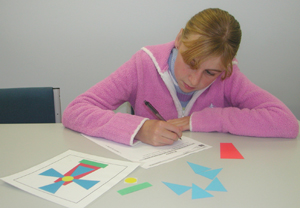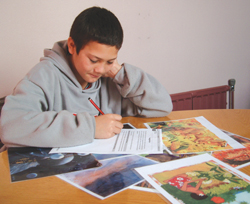| Although national
monitoring has been designed primarily to present an overall national
picture of student achievement, there is some provision for reporting
on performance differences among subgroups of the sample. Seven demographic
variables are available for creating subgroups, with students divided
into two or three subgroups on each variable, as detailed in Key
Features, page 4..
The analyses of the relative performance of subgroups used an overall
score for each task, created by adding scores for the most important components
of the task.
Where only two subgroups were compared, differences in task performance
between the two subgroups were checked for statistical significance using
t-tests. Where three subgroups were compared, one way analysis of variance
was used to check for statistically significant differences among the
three subgroups.
| Because
the number of students included in each analysis was quite large (approximately
450), the statistical tests were quite sensitive to small differences.
To reduce the likelihood of attention being drawn to unimportant differences,
the critical level for statistical significance was set at p = .01
(so that differences this large or larger among the subgroups would
not be expected by chance in more than one percent of cases). For
team tasks, the critical level was raised to p = .05, because of the
smaller sample size (120 teams, rather than about 450 students). |
 |
For the first four
of the seven demographic variables, statistically significant differences
among the subgroups were found for less than fifteen percent of the tasks
at both year 4 and year 8. For the remaining three variables, statistically
significant differences were found on a substantial proportion of tasks
at one or both levels. In the report below, all “differences”
mentioned are statistically significant differences (to save space, the
words “statistically significant” are omitted)
School type
Results were compared for year 8 students attending full primary and intermediate
schools. No differences were found on any of the 35 tasks or any questions
of the Writing Survey
School size
Results were compared from students in larger, medium sized, and small
schools (exact definitions were given in Chapter 1).
For year 4 students, there were differences among the three subgroups
on 3 of the 29 tasks. On Link
Task 1 and Link Task
13 , students from small schools scored highest, with students from
medium sized schools lowest on the former and students from large schools
lowest on the latter. On Accident
Report, students from large schools scored lowest. There were no differences
on questions of the Writing Survey
.
For year 8 students, no differences were found on any of the 35 tasks
or any questions of the Writing Survey
Community size
Results were compared for students living in communities containing over
100,000 people (main centres), communities containing 10,000 to 100,000
people (provincial towns), and communities containing less than 10,000
people (rural areas).
For year 4 students,
there were differences among the three subgroups on 2 of the 29 tasks.
Students from rural areas scored lowest on Link
Task 12 and Link Task
13 , with students from main centres highest on the latter. There
was also a difference on one question of the Writing
Survey, with students from provincial towns least frequently having
brothers or sisters read their writing (question 11).
For year 8 students, there were differences on 2 of the 35 tasks. Students
from rural areas scored lowest on both Spots
and Spelling, with
students from provincial towns highest on the former. There were no differences
on questions of the Writing Survey.
Zone
Results achieved by students from Auckland, the rest of the North Island,
and the South Island were compared.
For year 4 students, there were differences among the three subgroups
on 4 of the 29 tasks. Students from Auckland scored lowest on Please,
Link Task 3, and Link
Task 4, with South Island students highest on Please.
Conversely, Auckland students were highest and South Island students lowest
on Link Task 1. There
were also differences on two questions of the Writing
Survey, with students from Auckland most positive about writing in
school (question 1) and students from the South Island least positive
about how good they thought they were at writing (question 2).
For year 8 students, there were differences among the three subgroups
on 5 of the 35 tasks. Students from Auckland were lowest on all five:
Link Task 2 , Windmills,
Postcard, Lost
Pet, and Link Task 9.
Four of these tasks were in chapter
4 (functional writing). There was also a difference on one question
of the Writing Survey, with students
from the South Island indicating less use of computers for writing at
school (question 14).
Student ethnicity
Results achieved by Mäori and non-Mäori students were compared.
For year 4 students, there were differences on 10 of the 28 tasks, spread
across chapters 3, 4
and 5. In each case, non-Mäori
students scored higher than Mäori students. The tasks involved were
Imagination, Opinions,
Link Tasks 1 and 4,
Phone Message, Windmills,
Lost Pet, Link
Task 9, Story Edit,
and Link Task 12. There
were also differences on three questions of the Writing
Survey, with Mäori students more positive about how good they
thought they were at writing (question 2), reporting that their parents
read their writing more frequently (question 10), and reporting that they
made more use of computers for writing at school (question 14).
For year 8 students, there were differences between Mäori and non-Mäori
students on 13 of the 34 tasks, spread across chapters 3,
4 and 5,
but most concentrated in chapter
5 (writing conventions). In each case, non-Mäori students scored
higher than Mäori students. The tasks involved were Link
Tasks 1, 4 and 5,
Phone Message, Postcard,
Link Tasks 9 and 10,
Spelling, Spelling
Corrections, Story
Edit, Shimbir, and
Link Tasks 14 and 15.
There were no differences on questions of the Writing
Survey.
Gender
Results achieved by male and female students were compared.
 |
For year 4 students, there were differences between boys and girls
on 11 of the 28 tasks, of which seven were in chapter
4 (functional writing). Girls scored higher than boys on all tasks.
The tasks involved were Opinions,
Link Tasks 1 and 2,
Thank You Letter,
Accident Report,
Phone Message,
Postcard, Link
Tasks 6, 8 and 10, and Link
Task 12. Girls also scored higher than boys on six questions of
the Writing Survey, indicating
greater enjoyment of writing at school (question 1), higher self-perception
as writers (question 2), more positive judgments of their writing
by both their teachers (question 3) and their parents (question 4),
greater enjoyment of writing in their own time (question 5), and greater
frequency of having some other person (question 13) read their writing. |
For year 8 students,
there were differences between boys and girls on 30 of the 34 tasks. Girls
scored higher than boys on all of these tasks. Because of the large number
of tasks involved, they will not be listed here. Girls also scored higher
than boys on three questions of the Writing
Survey, indicating greater enjoyment of writing at school (question
1) and in their own time (question 5), and greater frequency of having
a friend read their writing (question 12).
Socio-economic index
Schools are categorised by the Ministry of Education based on census data
for the census mesh blocks where children attending the schools live.
The SES index takes into account household income levels, categories of
employment, and the ethnic mix in the census mesh blocks. The SES index
uses ten subdivisions, each containing ten percent of schools (deciles
1 to 10). For our purposes, the bottom three deciles (1-3) formed the
low SES group, the middle four deciles (4-7) formed the medium SES group,
and the top three deciles (8-10) formed the high SES group. Results were
compared for students attending schools in each of these three SES groups.
For year 4 students, there were differences among the three subgroups
on 21 of the 29 tasks. Because of the large number of tasks involved,
they will not be listed here. Students in the low SES schools performed
worst. In general, there was a steady trend of improvement from lower
SES schools to higher SES schools. There were also differences on two
questions of the Writing Survey, with
students from low SES schools indicating more positive self-perceptions
of their writing skills (question 2), and greater frequency of use of
computers for writing at school (question 14).
For year 8 students, there were differences among the three subgroups
on 29 of the 35 tasks. In general, there was a steady trend of improvement
from lower SES schools to higher SES schools. There were also differences
on four questions of the Writing Survey,
with students from low SES schools more positive about writing at school
(question 1) and in their own time (question 5), and indicating a higher
frequency of writing things like stories, poems or letters at school (question
7) and of sharing their writing with brothers or sisters (question 11).
Summary
| School
type (full primary or intermediate), school size, community size or
geographic zone did not seem to be important factors predicting achievement
on the writing tasks, or on attitudes to writing. Non-Mäori students
outperformed Mäori students on about thirty-five percent of the
tasks at both year levels. There were statistically significant differences
in the performance of students from low, medium and high decile schools
on 72 percent of the year 4 tasks and 83 percent of the year 8 tasks.
The most startling result, however, involved the comparison of results
for boys and girls. Girls performed better than boys on 39 percent
of the year 4 tasks, but on 88 percent of the year 8 tasks. At both
levels, girls also displayed more positive attitudes to writing. |
 |
Between 1998 and
2002, there have been noticeable changes in subgroup differences for three
of the seven variables. The only variable showing a change for year 8
students was the SES index (based on school decile), with the percentage
of tasks showing performance differences increasing from 72 percent in
1998 to 83 percent in 2002. For year 4 students, however, three variables
showed reduced disparity in 2002. The percentage of tasks on which year
4 Mäori students scored lower than non-Mäori students decreased
from 46 percent in 1998 to 36 percent in 2002. Similarly, the percentage
of tasks on which year 4 students from low SES (decile) schools scored
lower than students from high SES schools decreased from 83 percent to
72 percent. The most dramatic change involved the percentage of tasks
on which year 4 girls performed better than boys, which decreased from
79 percent in 1998 to 39 percent in 2002.
|